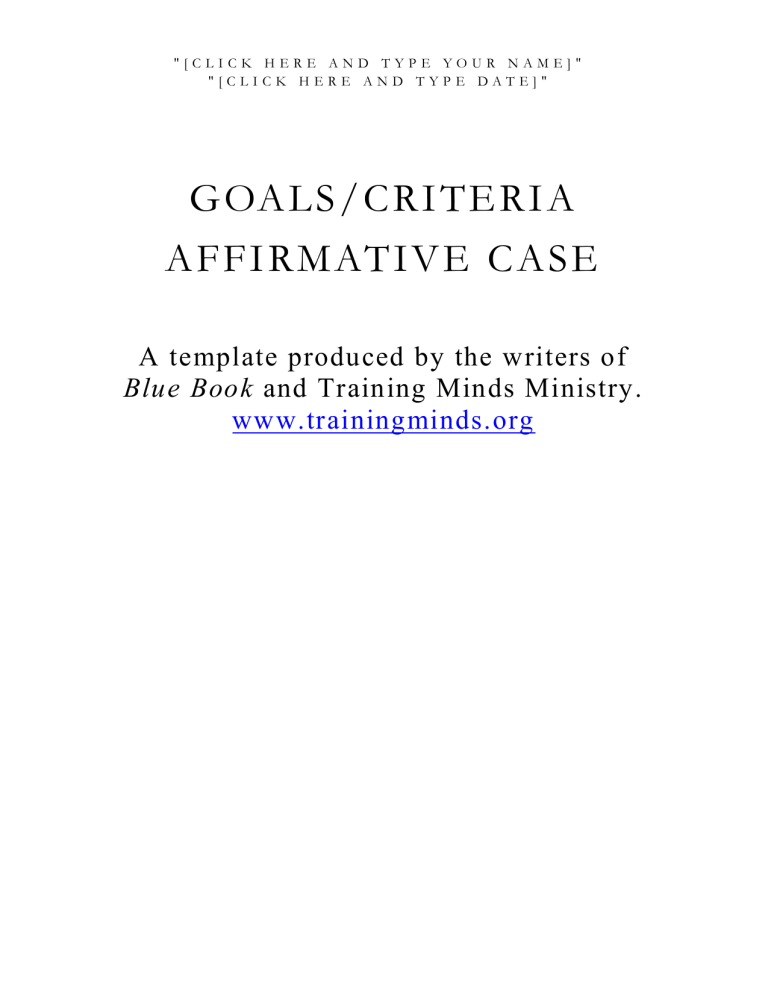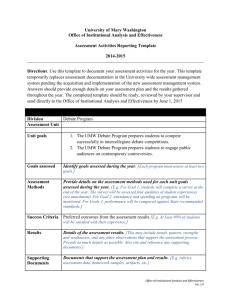How to Use This Template - Training Minds Ministry

" [ C L I C K H E R E A N D T Y P E Y O U R N A M E ] "
" [ C L I C K H E R E A N D T Y P E D A T E ] "
GOALS/CRITERIA
AFFIRMATIVE CASE
A template produced by the writers of
Blue Book and Training Minds Ministry. www.trainingminds.org
How to Use This Template
Welcome to Training Minds Ministry's Comparative Advantage Affirmative Case
Template. We hope you find this template useful in creating your debate case. This template is designed to be used alongside Blue Book. If you do not have these publications, click here .
The Blue Book has several debate cases, one of which is offered free online ( click here to view). You can refer to these cases as models on how to write your own case. This template is one of many ways you can outline a debate case. Change the information on this template to contain the information you would like. For the body of your case, use
Styles such as Heading 1-5, Body Text, Block Quotation, List Bullet, and List Number from the Style control on the Formatting toolbar. For evidence quotations, use Styles such as Contention, Citation and Evidence "Char" (abbreviation for "Characters").
This report template is complete with Styles for a Table of Contents and an Index. From the Insert menu, choose Reference, Index and Tables. Click on the tab you would like.
How to Customize This Report
This template is a tool to use to get you going on debate case development, but it is important to note that this template isn't the only way to write a debate case. Don't think you need to stick with TMM's version of this template. You are free to modify this template as much as you want. To create your own customized version of this template, select File New General Templates and choose this template. Be sure to indicate
"template" as the document type in the bottom right corner of the dialog. You will then be able to make changes and save the template with a custom name.
1) Insert your name and the date in place of the text on the cover page by clicking once and typing.
2) Choose File Save As. At the bottom of the menu, choose Document Template in the Save File as Type: box. (The filename extension should change from .doc to
.dot.) Save the file under a new name to protect the original version, or use the same template name to replace the existing version.
When Finished
When you are finished writing your case, take the time to read it aloud, timing yourself along the way. Your case should be read smoothly (no speed reading) within an 8-minute constructive. Be sure to use a convincing voice as you are giving a polished rhetorical speech to the judge. You may find that you need to cut a little here, revise a little there, do whatever needed to make your debate case persuadable and convincing.
Goals/Criteria Debate Case - 2
Don't Stop Here
Don't ever think you have a fool-proof case. You don't, no matter how good you think it is. In fact, jump the gun and start writing a negative brief against your own case. Surely you came across evidence that argued against your case. Keep this evidence and write briefs that attack your case. Then write defenses to these briefs. This will prepare you for the tournament when you hear these arguments from your opponents.
Goals/Criteria Debate Case - 3
A F F I I R M A T I I V E T I I T L E
USE THIS SPACE TO TYPE A THESIS STATEMENT THAT EXPLAINS IN
ONE OR TWO SENTENCES YOUR ENTIRE CASE.
Write your introduction. Though this appears at the beginning of your case, you may want to wait to write this till you have filled out the rest of your case. An introduction gives a general preview of your case as well as provides the opportunity to persuade the judge in principle. You will be leading the judge through a structured, 8-minute argument, so present the introduction in simple terms that will give the judge a general understanding of where you are taking this.
OBSERVATION 1. TOPICALITY:
THE AFFIRMATIVE CASE MEETS A REASONABLE DEFINITION OF THE RESOLUTION
A. Definitions
Here you want to define the various terms within the resolution like "significant,"
"change," "policy," and "protectorate." Take care in defining "protectorate," as the Blue
Book goes into detail explaining. There is not a solid definition of this term, and if the
Affirmative team is wishy-washy in their attempt to define it for the round, they will most certainly be hit hard with a topicality argument.
B. Analysis
Take the time to analyze the resolution. This is the attempt by your team to assess the resolution for what it says and give confidence to the judge that your case is topical.
OBSERVATION 2. THE GOAL OF CURRENT POLICY IS Q
[example: Q = "promoting democracy in the Middle East" or "reducing unemployment," etc.]
A. Subpoint 1: The President says he is pursuing this goal
Citation
Evidence
B. Subpoint 2: Federal agencies are spending $Y to achieve this goal
Citation
Evidence
Goals/Criteria Debate Case - 4
C. Subpoint 3: Joe Expert says this is the goal of our foreign and/or domestic policy
Citation
Evidence
To better meet the goals of our [economic, foreign, military, etc.] policy, we offer the following plan.
Plank 1
Plank 2
Plank 3
Plank 4
Plank 5
Plank 6
Agency.
Mandates. Public policy is changed to do policy Z instead of policy X.
Funding.
Enforcement.
Timing.
Legislative Intent.
OBSERVATION 4. THIS PLAN ACHIEVES THE GOAL OF Q BETTER THAN THE STATUS
QUO
This section will be backed up with evidence that shows that the plan you are proposing achieves the goals of the United States better than the status quo.
A. The Status Quo is committed to policy X
Citation
Evidence
B. Status Quo policy X fails to meet goal Q
Citation
Evidence
C. Policy Z meets goal Q much better than the Status Quo
1. Increased occurrence of Q
Citation
Evidence
2. Q will happen in multiple locations
Citation
Evidence
3. Much more Q will happen if Z is implemented
Citation
Evidence
Goals/Criteria Debate Case - 5
D. [Optional] Policy Z produces additional Advantages
1. Advantage 1
Citation
Evidence
2. Advantage 2
Citation
Evidence
Now take the time to write your conclusion. You may want to state, word-for-word, the thesis of your entire case. Revisit your introduction and ask yourself, "How does this case convince the judge that the plan should be implemented?" Then write this argument down in the conclusion.
Goals/Criteria Debate Case - 6







